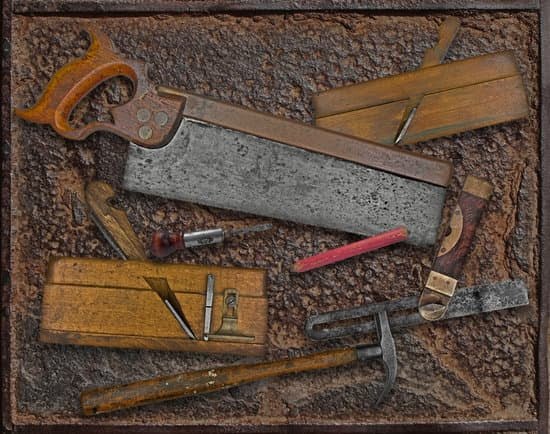What is a veneer woodworking? Veneer woodworking is a technique that involves using thin slices of wood to enhance the appearance of furniture, cabinetry, and other woodworking projects. In this article, we will explore the history and origin of veneer woodworking, the different types of materials and techniques used, as well as the benefits and advantages of using veneer in carpentry.
Veneer woodworking has been around for centuries and has its origins in ancient Egyptian and Roman civilizations. Over time, this technique has evolved and expanded to include a wide variety of materials such as wood veneers, decorative laminates, and even metallic veneers.
One of the key advantages of using veneer in woodworking is its ability to showcase the natural beauty of wood grain while also allowing for more flexibility in design. Additionally, veneer is often more cost-effective than using solid wood for large-scale projects, making it an attractive option for both professional woodworkers and hobbyists alike. These are just a few reasons why veneer woodworking continues to be popular in the carpentry industry today.
The History and Origin of Veneer Woodworking
Veneer woodworking has a long and rich history, dating back to ancient civilizations such as the Egyptians, who used veneer woodworking techniques in their furniture and decorative arts. The practice of veneering involves covering a base material with a thin layer of high-quality wood to enhance its appearance. This technique has been employed for centuries and continues to be a popular method in the carpentry industry.
The use of veneer woodworking can be traced back to as early as 3000 BC, where it was utilized in the construction of furniture, sculptures, and architectural elements. In ancient Egyptian furniture, for example, ebony and ivory veneers were frequently used to adorn boxes and chests. Veneer woodworking was also prominent in ancient Greek and Roman cultures, with intricate patterns and designs created using various types of wood veneers.
As time progressed, different cultures and regions developed their own unique methods of veneer woodworking. In Asia, especially in China and Japan, artisans used specialized techniques such as “tiger stripe” or “bee-wing” patterns to create stunning visual effects on furniture pieces.
The European Renaissance period also saw a resurgence in the popularity of veneer woodworking, with elaborate marquetry designs adorning luxurious furniture items. Today, veneer woodworking continues to be a widely practiced art form that combines traditional craftsmanship with modern technology.
| Veneer Woodworking | History |
|---|---|
| Ancient Egyptian civilization | 3000 BC |
| Greek and Roman cultures | Intricate patterns with different types of wood |
| China and Japan | “Tiger stripe” or “bee-wing” patterns |
Types of Veneer Woodworking Materials and Techniques
Veneer woodworking involves the use of thin slices of wood, known as veneers, to create a decorative or protective layer on the surface of furniture and other woodworking projects. There are various types of materials and techniques used in veneer woodworking, each with its own unique characteristics and applications.
One common type of veneer material is natural wood veneer, which is made by slicing thin layers from a log using a specialized cutting tool. These veneers showcase the natural beauty and grain patterns of the wood, adding warmth and elegance to furniture pieces.
Another type is reconstituted veneer, which is made from fast-growing and sustainable wood species that are dyed and bonded together to resemble exotic hardwoods. This type of veneer offers a more affordable alternative while still providing a high-quality finish.
In addition to the different types of veneer materials, there are also various techniques used in veneer woodworking. Traditional methods include book matching, where two consecutive slices of veneer are opened like a book to create a mirrored pattern, and slip matching, where consecutive slices are used in sequence to create a uniform appearance.
More modern techniques involve the use of advanced machinery such as laser cutting for precision shaping and trimming of veneers. These techniques allow for intricate designs and customizations, giving woodworkers greater flexibility in their projects.
Overall, understanding the different types of materials and techniques available in veneer woodworking can help woodworkers select the most suitable options for their specific projects. Whether it’s creating a luxurious finish with natural wood veneers or achieving cost-effective yet attractive results with reconstituted veneers, having knowledge about these materials and techniques is essential for successful woodworking projects.
Benefits and Advantages of Veneer Woodworking
Veneer woodworking offers several benefits and advantages that make it a popular choice among carpenters and furniture makers. From its aesthetic appeal to its practicality, veneer woodworking is a versatile technique that has stood the test of time.
Enhanced Aesthetics
One of the main advantages of veneer woodworking is the enhanced aesthetics it provides to wooden surfaces. Veneer allows for the use of exotic and rare wood species that may be difficult to obtain in solid form. This creates a visually stunning finished product with unique grain patterns and colors, making it an attractive option for high-end furniture and cabinetry.
Cost-Effectiveness
Compared to solid wood, veneer woodworking is often more cost-effective. By using a thin layer of high-quality wood over more affordable substrates like plywood or MDF (medium-density fiberboard), craftsmen can achieve the look and feel of solid wood without the hefty price tag. This makes veneer woodworking an accessible option for both professionals and hobbyists looking to create beautiful, yet budget-friendly pieces.
Stability and Durability
In addition to its visual appeal and cost-effectiveness, veneer woodworking also offers increased stability and durability compared to solid wood. Veneer is less prone to warping or splitting, making it an ideal choice for large surfaces like tabletops or cabinet doors. Its thin construction also allows for flexibility, reducing the risk of cracking or breaking under pressure. This makes veneer woodworking a practical choice for projects that require longevity and resilience.
Common Applications of Veneer Woodworking in Furniture Making
When it comes to furniture making, veneer woodworking is a popular technique that offers a wide range of applications. Veneer woodworking involves the process of applying thin layers of wood to a base material in order to create a more visually appealing surface. This technique allows for flexibility in design and can enhance the overall look and feel of the furniture piece.
Enhancing Aesthetics
One of the most common applications of veneer woodworking in furniture making is enhancing the aesthetic appeal of the finished product. By using veneer, woodworkers are able to achieve intricate and decorative patterns that may be difficult to achieve with solid wood alone. This allows for greater design versatility and can elevate the overall visual impact of the furniture piece.
Repairing Imperfections
Veneer woodworking also has practical applications when it comes to repairing imperfections in wood. In furniture making, veneer can be used to cover up knots, cracks, or other blemishes in the base material, creating a smooth and flawless surface. This not only improves the appearance of the piece but also helps to prolong its lifespan by protecting it from further damage.
Cost-Effective Design Options
Furthermore, veneer woodworking offers cost-effective design options for furniture makers. Using veneer allows for the use of expensive or exotic wood species on just small portions of a piece rather than constructing an entire piece from solid exotic woods.
This makes it possible to achieve a high-end look without the hefty price tag, making it an attractive option for both consumers and manufacturers alike. Overall, veneer woodworking is an invaluable technique in furniture making that provides countless benefits and opportunities for creativity within the industry.
How to Properly Choose and Use Veneer Woodworking Supplies
Veneer woodworking supplies are essential in creating stunning and durable woodwork pieces. Choosing the right veneer woodworking supplies can make all the difference in the outcome of your project. Here are some tips on how to properly choose and use veneer woodworking supplies:
- Research and Education: Before diving into a veneer woodworking project, it’s crucial to understand the different types of veneer materials available. Whether it be raw, paper-backed, or wood-on-wood veneers, each type has its own unique characteristics and applications. Take the time to research and educate yourself on the various options.
- Quality Over Price: When choosing veneer woodworking supplies, it’s important to prioritize quality over price. Opting for high-quality veneer materials may come with a higher price tag, but it ensures that your finished piece will be durable and visually appealing.
- Proper Handling and Preparation: Once you have chosen the right veneer material for your project, proper handling and preparation are key. Veneer materials can be fragile and prone to damage if not handled carefully. Make sure to store them in a controlled environment to prevent warping or cracking. Additionally, take the time to properly prepare the surface where the veneer will be applied to ensure optimal adhesion.
Using these tips, you can effectively choose and utilize Veneer Woodworking Supplies What is a Veneer Woodworking? while creating beautiful and long-lasting woodwork projects that showcase the natural beauty of wood grains without breaking the bank or compromising on quality.
Potential Challenges and Pitfalls in Veneer Woodworking
Working with veneer woodworking can present its own set of challenges and pitfalls, especially for beginners or those unfamiliar with the material. One common challenge is the fragility of veneer, which can be prone to cracking or chipping if not handled carefully. This is especially true when cutting or sanding the material, requiring a delicate touch and precision to avoid damage.
Another potential issue in veneer woodworking is the risk of warping or buckling. Since veneer is thin and attached to a substrate, changes in humidity or temperature can cause the material to warp or buckle, leading to an uneven surface or even delamination. Proper storage and acclimation of veneer sheets before use can help mitigate this risk.
Additionally, matching and blending different pieces of veneer together to create a seamless look can be challenging, especially when working with intricate patterns or grain variations. This requires careful consideration and skillful application to achieve a visually appealing result.
Despite these challenges, many woodworkers find that the stunning appearance and versatility of veneer make it a worthwhile material to work with, once they have mastered the techniques required. With patience, practice, and attention to detail, these potential pitfalls can be effectively managed for successful veneer woodworking projects.
| Challenges | How to Address |
|---|---|
| Fragility of veneer | Handle with care during cutting and sanding |
| Risk of warping or buckling | Proper storage and acclimation before use |
| Matching different pieces of veneer | Careful consideration and skillful application |
Maintenance and Care of Veneer Woodworking Projects
Veneer woodworking projects can add a touch of elegance and sophistication to any piece of furniture. However, it’s important to properly maintain and care for these projects to ensure their longevity and beauty. Here are some tips on how to maintain and care for veneer woodworking projects:
- Regular Cleaning: Dust and debris can accumulate on veneer woodworking projects, so it’s important to regularly dust and clean them with a soft cloth or brush. Avoid using abrasive cleaning tools or harsh chemicals, as these can damage the veneer.
- Avoid Direct Sunlight: Direct sunlight can cause the veneer to fade and become discolored over time. To prevent this, place your veneer woodworking projects away from direct sunlight or use curtains or blinds to block out the sun.
- Protect from Moisture: Veneer is susceptible to moisture damage, so it’s important to protect your woodworking projects from excessive humidity or moisture. Use coasters or placemats to prevent water rings on tabletops, and consider investing in a dehumidifier for the room where your veneer furniture is located.
Proper maintenance of veneer woodworking projects will not only preserve their beauty but also extend their lifespan. By following these simple care tips, you can enjoy the natural beauty of wood veneer for years to come.
In addition, if you’re unable to maintain or care for your veneer woodworking projects yourself, consider hiring a professional furniture restoration expert who specializes in working with wood veneers. They can provide proper cleaning, repair any damages, and offer advice on how to best care for your specific type of veneer woodworking project.
Conclusion
In conclusion, veneer woodworking has a long and rich history, dating back to ancient Egypt. The technique of using thin layers of wood to create intricate and decorative patterns has evolved over the centuries, resulting in a wide array of materials and techniques used in modern veneer woodworking. From traditional hand-cut veneers to the use of advanced machinery for slicing and peeling, the possibilities for creating stunning veneer woodworking projects are endless.
The benefits and advantages of veneer woodworking are numerous, including cost-effectiveness, sustainability, and the ability to achieve beautiful designs that may not be possible with solid wood alone. Additionally, the common applications of veneer woodworking in furniture making have led to the creation of exquisite pieces that are both durable and visually appealing.
Despite the potential challenges and pitfalls in working with veneer woodworking supplies, proper maintenance and care can ensure that projects stand the test of time. As the carpentry industry continues to evolve, it is clear that veneer woodworking will remain a valuable skill for craftsmen and hobbyists alike. With advancements in technology and an increasing focus on sustainable practices, the future of veneer woodworking is bright, promising new innovations and exciting possibilities for creating stunning woodwork masterpieces.
Frequently Asked Questions
What Is an Example of a Veneer Wood?
An example of a veneer wood is oak. Oak veneer is made by slicing very thin layers of oak wood from a log, which are then attached to a base material such as plywood or MDF to create the appearance of solid oak.
How Can You Tell if a Table Is Wood or Veneer?
You can tell if a table is wood or veneer by examining the edges and looking for a thin layer of the table’s surface material over another material, such as particle board or MDF. Veneer tables will often have an edge where you can see the thin layer of the surface material.
What Is a Veneer Finish?
A veneer finish refers to a thin layer of decorative wood that is applied to a surface, such as furniture or cabinetry, to give it the appearance of being made from solid wood.
The veneer finish can be made from a variety of different wood species and can add an attractive and natural look to the item it is applied to.

Hi everyone! I’m a woodworker and blogger, and this is my woodworking blog. In my blog, I share tips and tricks for woodworkers of all skill levels, as well as project ideas that you can try yourself.




